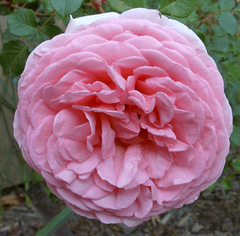About 5 years ago I bought and planted dozens of these checkered flower bulbs. I'm a sucker for the drooping bell shape and the unusual coloration. But the Fritillaria meleagris likes moist but well-drained soils and I've got heavy clay. My garden soil is slowly getting better as I add more and more compost each year.
After I saw not a one of these flowers appear, I purchased a few dozen more and tried again. And failed again - so I thought. Some interesting foliage had sprouted where I buried the bulbs, but I couldn't be sure what it was. Next season, I gave up and didn't plant anymore. Instead I tried to be happy with my successful plantings of Fritillaria uva-vulpis . This other fritillaria is known by the strange moniker Fox's Grape. Foxes must have a very different idea of what a grape is.... While they are also beautiful, they don't have the odd and wonderful checkered shading that I find so appealing in its cousin.
Now years later, the snake head emerges! Here she is at the base of a jessamine/jasmine hybrid vine, nodding serenely. A second bloom at her feet offers a clue to suggest it wasn't just the soil plotting against her. The felled bloom has the fine angled cut of a bunnie's bite on its stem. Rascally rabbits!
The arrival of a clan of feral cats that adopted our property late last summer have made this beautiful vision possible. Although we still have a few visits from the woodland bunnies, they are not nibbling as much of the spring garden this year. The foliage of the Guinea Hen flower has been arriving faithfully and without fanfare, but until now its blooms have been devoured. With the patrols of the orange army of cats - who interestingly enough hail from the same woodlands nearby that is also home to the hungry rabbits - this elegant flower that has become endangered in the wild, is finally safe in my garden.















